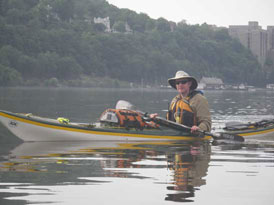The Merlin LT was the original do-it-all kayak. The first Merlins came out in the late 1990s. I have one of the first 200 ever made. It is an amazing design. This kayak is 13’6” long and weighed only 35 pounds! New Merlins weigh a bit more because they added more outfitting and a cushy seat. The secret to the weight savings is Eddlyline’s proprietary Carbonlite 2000, which is actually thermo-formed plastic. It is lightweight, yet incredibly stiff.
This kayak has virtually no rocker so the whole kayak is waterline. This makes the Merlin incredibly fast for such a small kayak. It can handle just about any conditions, except rocks. Thermo-formed plastic is not quite as tough as roto-molded.
 |
| The Merlin kayak has a long water line. Only about 6" of the length sits out of the water. |
The LT model fits small to medium sized paddlers, while there is an XT version for larger paddlers. The outfitting has been upgraded over the years and includes a cushy seat, dual bulkheads, and deck bungees.
This kayak is so versatile and so much fun to paddle, that it is one of only three kayaks that has earned a place in my permanent fleet. Each spring, the Merlin is the first kayak I paddle to start off the season.
Pros: Very light weight, medium initial stability. Very responsive and fast for its size.
Cons: Expensive compared to roto-molded. Must be careful around rocks.
Best Uses: Day paddling in quiet to big water.
See you on the water,
Don Urmston
Mrurmston@gmail.com











